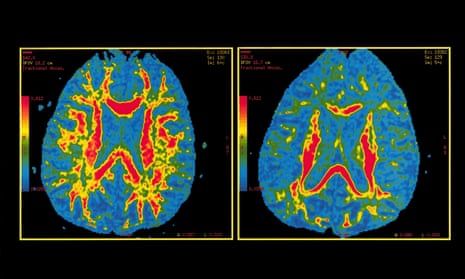Scientists have developed a new genetic test for Alzheimer’s risk that can be used to predict the age at which a person will develop the disease.
A high score on the test, which is based on 31 genetic markers, can translate to being diagnosed many years earlier than those with a low-risk genetic profile, the study found. Those ranked in the top 10% in terms of risk were more than three times as likely to develop Alzheimer’s during the course of the study, and did so more than a decade before those who ranked in the lowest 10%.
Rahul Desikan, of the University of California – who led the international effort, said the test could be used to calculate any individual’s risk of developing Alzheimer’s that year.
“That is, if you don’t already have dementia, what is your yearly risk for AD onset, based on your age and genetic information,” he said.
The so-called polygenic hazard score test was developed using genetic data from more than 70,000 individuals, including patients with Alzheimer’s disease and healthy elderly people.
It is already known that genetics plays a powerful role in Alzheimer’s. Around a quarter of patients have a strong family history of the disease, and scientists have shown this is partly explained by a gene called ApoE, which comes in three versions, and is known to have a powerful influence on the risk of getting the most common late-onset type of Alzheimer’s. One version of ApoE appears to reduce risk by up to 40%, while those with two copies (one from each parent) of the high-risk version can increase risk by 12 times.
The latest study takes a new approach, showing that, aside from ApoE, there are thousands of background genetic variations that each have a tiny influence on Alzheimer’s risk, but whose cumulative influence is substantial.
The researchers first identified nearly 2,000 single letter differences in the genetic code (known as SNPs) and, after ranking them for influence, developed a test based on 31 of the markers. The test was then used to accurately predict an individual’s risk of getting the disease in an independent patient cohort.
In people with the high-risk version of ApoE, those ranked in the top 10% of risk on the new test got Alzheimer’s at an average age of 84 years, compared with 95 years for those ranked in the lowest 10%.
James Pickett, head of research at Alzheimer’s Society, said: “Preventing the development of dementia symptoms is the holy grail of Alzheimer’s research but to succeed we first need accurate methods to predict who is most likely to develop the condition. This study’s approach was fairly successful at predicting the likelihood of someone developing dementia over the coming year, but needs to be tested further in mixed, non-US populations.”
Pickett added that, while the score could help to identify people for trials, it was too early to apply it as a genetic testing tool for use in the clinic.
Rosa Sancho, head of research at Alzheimer’s Research UK, said that while genetic makeup can influence the chances of developing dementia, a healthy diet, regular physical activity and remaining mentally active can also drive down the risk. “Genetics is only part of the story and we know that lifestyle factors also influence our risk of developing Alzheimer’s,” she said. “The best current evidence points to habits we can all adopt to help lower our risk and indicates that what’s good for your heart is also good for the brain.”
The findings are published in the journal PLOS Medicine.
